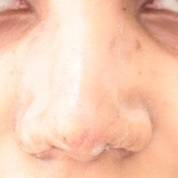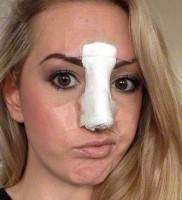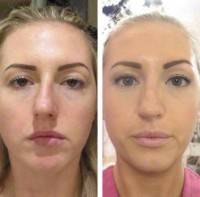Septoplasty And Rhinoplasty Surgery To Remove Bump
Rhinoplasty after Septoplasty- Using septal Cartilage to shape nose
It is possible to have a rhinoplasty done after a septoplasty, although it is best to have them done at the same time so that the removed septal cartilage can be used to rebuild and reshape the nose during rhinoplasty. The nasal wall dent or deformity that is apparent in your picture can be corrected by cartilage grafting to the area of the upper lateral cartilage which would most likely be done in a form of a “spreader graft”.
If you don’t have much septal cartilage left after a septoplasty, then you might need to have ear cartilage used to repair your nasal deformity. (S. Sean Younai, MD, FACS, Beverly Hills Plastic Surgeon)
Rhinoplasty for crooked nose can be successful after septoplasty
To be short and sweet with this answer, your nose can be made More straight and your breathing better with a revision septiplasty and rhinoplasty.
Seek another consult with a facial plastic surgeon or plastic surgeon who specializes in rhinoplasty for another opinion.
The septum is the base and strength of the nose and likely needs to be Repaired with an external rhinoplasty approach. I don’t recommend fillers for this. (Travis T. Tollefson, MD, MPH, Sacramento Facial Plastic Surgeon)
Rhinoplasty or “Secondary” Septorhinoplasty after Septoplasty
Although ideally you should have performed a septorhinoplasty as the first operation, a secondary operation is quite feasible. Primary surgery is easier than secondary surgery, and if a septoplasty had not been performed, your surgeon would have had an abundance of the most ideal cartilage for all “building” purposes.
You should visit with a surgeon who has experience with secondary rhinoplasty operations, and just understand that there is a higher likelihood that distant cartilage donor sites (such as ear or rib) might be needed to complete the operation.
Look for ASAPS members who have an interest in rhinoplasty surgery, or better yet, members of The Rhinoplasty Society. (Michael A. Bogdan, MD, FACS, Dallas Plastic Surgeon)
Rhinoplasty after septoplasty
It is usually necessary to reoperate on the septum in patients who are still having problems breathing after a previous septoplasty. This can be done at the same time as a rhinoplasty and is often necessary to straighten a crooked nose.
Your chance of a successful outcome is enhanced by seeing a plastic surgeon who is very experienced in rhinoplasty and revision (redo) rhinoplasty. (Richard Chaffoo, MD, FACS, San Diego Plastic Surgeon)
Rhinoplasty after a septoplasty
Rhinoplasty after a septoplasty is certainly possible. In fact, many of the rhinoplasties that I perform are after a failed previous septoplasty. Sometimes, a septoplasty can provide enough improvement on its own for breathing reasons.
Most of the time, however, with the amount of deviation that you have (which is visible on the outside) a septorhinoplasty is necessary. This procedure would aim to straighten out the entire septum (particularly the portion that is deviated high up where the septum meets the nasal bones).
Additionally, the nasal bones could be fractured and straightened at the same time to improve the depression. You are right that the amount of cartilage removed during your previous procedure is an important factor.
Sometimes, in order to have more cartilage to use for structural grafts (to build up support in the nose) ear or rib cartilage can be used. (Jamil Asaria, MD, Toronto Facial Plastic Surgeon)
Rhinoplasty after septoplasty can be tricky. It has to be handled the right way by someone with experience in cosmetic and functional surgery in order to avoid the issues you describe.
It sounds like you had a submucus resection type septoplasty where the non-structural cartilage is removed. That is unfortunate but no uncommon either.
What is left is the structural parts of the septum, also referred to as the L-strut. That L strut can be manipulated, provided the surgeon appreciates what your margin of safety is.
The deviation can still be addressed and further straightening of your airway should be possible. If cartilage grafts are required, then ear cartilage is likely required, since your septum can no longer be used for that purpose.
There can be limitations on profile reduction, depending on how much cartilage is left on the top of the nose. If the majority of the septum is not instrumented again, then your risk of perforation should be very low.
There is no real reason to re-do the septoplasty, unless crooked cartilage is still present. If that is the case, then the perforation risk is not particularly high.
Found the right surgeon and your goals should be achieved. (Richard W. Westreich, MD, Manhattan Facial Plastic Surgeon)
You definitely need a rhinoplasty and you need to see a surgeon with comfort and experience in deviated noses and revision noses. One additional challenge you now have is in the availability of nasal septal cartilage for grafting. To lift out and repair the concavity (deptession) you have on the left will likely require spreader grating.
Since we don’t know how much of your septum may have been removed during the previous surgery you may require ear cartilage grafting. These challenges should not deter you just make sure you find the right surgeon. (Michael L. Schwartz, MD, West Palm Beach Facial Plastic Surgeon)
Rhinoplasty after septoplasty
It is certailny possible to perform a rhinoplasty after septoplasty. You may need a spreader graft on the depressed side to camouflage the asymmetry. But remember, realistically the nose will never be perfectly straight. (Steven Wallach, MD, Manhattan Plastic Surgeon)
Rhinoplasty after previous septoplasty
A rhinoplasty may still be done after previous septoplasty, but you may need cartilage harvest from another source if requires. This is usally the ear and in severe cases rib cartilage may be used. You should see an experienced surgeon who is well trained in revision rhinoplasty. (Donald Nunn, MD, Atlanta Plastic Surgeon)
Rhinoplasty revision after septoplasty
The nose can be re operated on but secondary surgeries are more complex , take longer and need a more skilled and experienced surgeon. Grafting may be needed. An open method preferred. A filler such as juvederm can give an idea as to how much it will help. If this is adequate a longer lasting filler such as radiesse can be used. So , there are several options depending on your needs and budget (Jed H. Horowitz, MD, FACS, Orange County Plastic Surgeon)
Fixing the crooked nose
Provided you are now breating well, your chief complaint is aesthetic. The nose must then be evaluated from the front, sides, and nostril view to determine which structures are causing and/or contributing to the crookedness, and any other existing aesthetic problems. A surgical plan must be developed, and adjusted depending on intra-operative findings.
These can be challenging procedures, because all nasal structures are interconnected, and generally, complete mobilization of all deviated parts is required, modification to straighten everything out, and then secure the straightened parts to stabilize in the midline. The easy solution is injectables to fill your unilateral concavity. Aquamid is ideal, or Radiesse. The correction of nostril view or profile problems may be limited. Since no profile or nostril view is submitted, I assume these are not huge issues for you. (Steve Laverson, MD, San Diego Plastic Surgeon)


